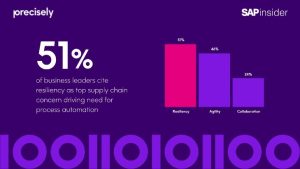
Leading that supply chain transformation is the need to automate processes within it. 89% of respondents believe process automation in the supply chain is either “important” or “very important” to attain digital transformation objectives.
In recent years supply chain disruptions have never been higher. The pandemic, the Suez canal blockage, the impact of global warming on weather, the Ukraine war and tension between Taiwan and China have all contributed. An increasingly complex landscape has contributed to the latest set of drivers for supply chain process automation
- Resiliency – 51%
- Agility – 46%
- Collaboration – 24%
Despite the work to digitally transform organisations over the last few years, supply chains seem to have been left behind. 72% of respondents indicate that under half of their processes are automated, with a third indicating that only a quarter of their processes are automated. So what can companies do?

John Reda, SVP – product management for data integration at Precisely, commented, “These new findings from SAPinsider highlight the importance of automation when it comes to complex, data-intensive, SAP processes, such as for supply chain. The Precisely Automate Evolve platform, formerly Winshuttle Evolve, helps customers to gain agility and speed by simplifying and streamlining processes.
“The flexible, scalable nature of the platform helps create and maintain resilient supply chains – delivering increased efficiency, visibility and governance that improve results and reduce the risks inherent in today’s unpredictable business environment.”
What is in the report?
The full report is 23 pages long and has an executive summary and three chapters after an executive summary.
- Process Automation in Supply Chain Overview
- How Do SAPinsiders Approach Process Automation in Supply Chain?
- Required Actions
The report is based on the findings from a survey of only 105 SAPInsiders with various responses across job functions, market sectors and geography. The geography sample was spread quite widely: North America (41%), EMEA (31%), APJ (22%) and LATAM (6%). Most worked in IT and BPM (69%), with only 14% working in supply chain and logistics.
The report follows the DART methodology, which aims to provide practical insights across four main themes macro level Drivers, Actions that can influence those drivers, Requirements for businesses to support the actions and Technology that is useful.
The report contains a mix of data visualisation and text, which is an analysis of the data uncovered. Within a sidebar, the authors have added quotes for SAPInsiders to offer a real-world perspective on the findings.
Executive Summary
98% of respondents said that process automation capabilities are at least moderately important to attaining supply chain transformation. It is backed by a qualitative insight from a Director of IT in the Industrial Manufacturing Industry: “Automating our end-to-end supply chain processes have provided us full visibility into our supply chain processes. This helps us operate a responsive supply chain.”
The summary shares some of the key findings below and summarises the actions needed. It also summarises the findings in a table based on DART delivering 19 statistics across the four criteria. The top in each category are
- Drivers: 51% see a need for supply chain resiliency
- Actions: 48% are looking to standardize their supply chain processes
- Requirements: 82% want an end to end supply chain visibility
- Technologies: 96% use or are considering order management solutions
Process Automation in Supply Chain Overview
This section provides insights into the state of supply chain process automation. It looks at the drivers behind supply chain process automation, with resiliency (51%) at the top of the list. It surfaces insights from another (paywall-gated) SAPinsider report, Supply Chain Planning in The Cloud, which noted the need to have flexible and scalable supply chain processes as one of the top reasons for exploring cloud-based supply chain planning capabilities.
There are three strategies used to enable the drivers of process automation.
- Process standardization (48%)
- Process Optimisation (41%)
- Process integration and visibility (36%)
This potentially shows the immaturity of the sector with a recent Accenture report considering interoperability is becoming a key factor in transformation; interoperability is a step beyond integration. The section then provides four takeaways for organisations to consider when moving their strategy forward.
How Do SAPinsiders Approach Process Automation in Supply Chain?
SAPInsiders already use the SAP platform, but not all use the SAP platform equally. The survey picks out the top required outcomes of process automation. The top three were:
- End-to-end process visibility (82%)
- Increased process efficiency (75%)
- Defining and documenting standardisation (77%)
The report then looks at these outcomes and seeks to understand why the respondents consider them important.
It moves on to looking at the technology currently in use and the one being looked at. While Data Management automation is the fourth most used technology (55%), it is not considered the highest. 47% of organisations are considering intelligent automation and CLM automation within the next two years. The latter is good news for Icertis. However, data quality and data management is an area that perhaps organisations are still forgetting despite it underpinning several of the required actions.
The section ends with four clear takeaways for the reader to follow.
Required Actions
According to SAPInsider, there are four key steps that organisations should take:
- Understand the underlying aspects of automation technologies as it applies to the supply chain
- Leverage RFIs and RFPs as strategic tools
- Build comprehensive process hubs that are tightly integrated with supply chain control towers.
- Explore process automation synergies with any planned SAP S/4HANA
Oddly these differ from the plans that are offered in the executive summary, which are:
- Build supply chain process monitoring and measurement capabilities.
- Define your unique supply chain process automation strategy and roadmap.
- Explore more advanced automation technologies.
- Build specialized reskilling training for your employees.
Underpinning several of these is a necessity to have data that business leaders can trust and is available. This means that systems must have seamless access to that trusted data. Trusted data requires data governance across all supply chain master data.
Reda commented: “Ultimately, supply chain resilience relies upon a programmatic approach for improving end-to-end process visibility and risk monitoring. To be successful, supply chains must become both digital and autonomous to keep pace with disruptive global events and changing consumer expectations.
“It’s clear that process automation is critical, but the success of digitised processes and workflows will also rely upon the accuracy, consistency and context of the data feeding them. Supply chain transformation, fuelled by data integrity, will be the key to confident decision-making during the uncertain times ahead.”
Enterprise Times: What does this mean?
The report is well written, but with such a small sample of main respondents in the IT function, it must be treated cautiously. The authors have sensibly not dived into many potential industry or regional differences within the report. However, it highlights the importance of transformation and what organisations want to adopt.
There is a risk, though, that while respondents feel that they want to invest in AI solutions, there is still a shortfall of investment in data management and data quality which is important for driving the performance of intelligent automation.
Mark Vigoroso, chief content officer at SAPinsider, commented, “While adoption of technologies has been slow to-date, the need to create a resilient supply chain ecosystem has never been more apparent, and we’re seeing organisations increasingly turn to process automation as a way to build robust supply chain capabilities and help navigate the uncertainty in the market.”
Precisely is also supporting the research with an on-demand webinar, “Process Automation Trends in SAP Supply Chain for 2023.”


























